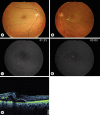Foveal Exudative Macroaneurysm Treated with Intravitreal Ranibizumab
- PMID: 26120315
- PMCID: PMC4478313
- DOI: 10.1159/000431353
Foveal Exudative Macroaneurysm Treated with Intravitreal Ranibizumab
Abstract
Purpose: We report a case of a foveal macroaneurysm with long-standing macular edema in a rare location, successfully treated with intravitreal ranibizumab.
Methods: We report the case of a 52-year-old man with left eye long-term visual loss due to macular edema caused by a retinal macroaneurysm, localized about 400 μm from the center of the fovea, and its response to 6 monthly ranibizumab intravitreal injections. His best-corrected visual acuity and morphological data evaluated by optical coherence tomography and fluorescein angiography are presented.
Results: His best-corrected visual acuity improved from 1/10 to 3/10 after the 3rd injection, and from 1/10 to 4/10 after the 6th one. The central retinal thickness was evaluated by optical coherence tomography and improved from 310 to 233 μm, with the resolution of both the associated serous detachments and the cystoid macular edema; an almost complete reabsorption of the hard exudates at the end of the treatment was also observed. The macroaneurysm lumen almost obliterated after the 3rd injection and completely collapsed at the end of treatment.
Conclusions: Intravitreal ranibizumab may be effective in the treatment of long-standing macular edema associated with foveal macroaneurysms. To the best of our knowledge, this is the first report of a retinal macroaneurysm located so close to the foveal avascular zone.
Keywords: Exudative retinal macroaneurysm; Fovea; Intravitreal ranibizumab.
Figures



References
-
- Pitkanen L, Tomilla P, Kaaniranta K, JaasKlainen JE, Kinnunen K. Retinal arterial macroaneurysms. Acta Ophthalmol. 2014;92:101–104. - PubMed
-
- Moosavi RA, Fong KC, Chopdar A. Retinal artery macroaneurysms: clinical and fluorescein angiographic features in 34 patients. Eye (Lond) 2006;20:1011–1020. - PubMed
-
- Meyer JC, Ahmad BU, Blinder KJ, Shah GK. Laser therapy versus observation for symptomatic retinal artery macroaneurysms. Graefes Arch Clin Exp Ophthalmol. 2015;253:537–541. - PubMed
-
- Chanana B, Azad RV. Intravitreal bevacizumab for macular edema secondary to retinal macroaneurysm. Eye. 2009;23:491–493. - PubMed
-
- Jonas JB, Schmid-Bauer M. Intravitreal bevacizumab for retinal macroaneurysm. Acta Ophthalmol. 2010;88:e284. - PubMed
Publication types
LinkOut - more resources
Full Text Sources

